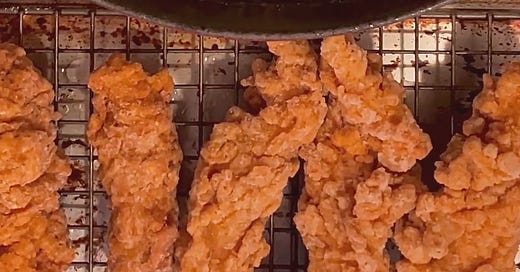1. Always make sure your oil is at optimum temperature. Too hot and the extreme temperature difference between the cool-to-lukewarm, often-moist food going in can cause serious steam and splatter, even overflow, as well as instant extra-dark fry annihilation. Too cool and you end up with greasy, oil-logged food instead of a crisp, light crunch. In my experience, this temperature sweet spot is usually somewhere in the 325°-350°F range (but as you’ll see with an upcoming recipe, sometimes a double-fry with a low- then high-temp is required for certain foods). Once the food goes in, the oil temperature will immediately start to drop, so cook in small batches and let your oil return to temperature after each. As you can (kind of) see in my video, I have a digital thermometer attached to the side of the pot, but you can also take individual readings with a handheld digital thermometer instead. (The crappy dial thermometers you get at the meat counter won’t cut it.)
2. Make sure your oil is at an acceptable level inside an appropriately deep pot. Your oil will ideally be 2- to 3-inches deep (any less is a shallow fry) and should never reach within 3 inches from the top of your pot. So use a pot at least 6-inches deep. I’ve seen firsthand what happens when there’s too much oil in a too shallow pot and too much food goes into very hot oil at once. At best there’s a huge, messy overflow which is a nightmare to clean, at worst there are serious burns and kitchen damage.
3. When you add your food to the oil, whether with fingers or tongs or a wire spider, be sure to angle it away from you so there’s no splashback onto your skin or clothes. As mentioned above, the immediate reaction will almost always be foaming oil and a release of steam, so you want to minimize contact.
4. Set a timer but keep a constant eye on the fry. The food will initially sink in the oil, and as the moisture in the the food’s surface is released as steam, the bubbles will be frenetically foaming on top of the oil, creating lots of crackling and hisses. As less and less moisture remains, the bubbles will get larger, slower and quieter, and the food will often float once it’s adequately cooked through.
5. After frying is finished, let the oil cool completely in the pot. I usually throw a lid on it and let it sit overnight. If I plan on using it again, I line a cone-shaped mesh strainer with a paper towel set it over a large bowl to transfer into. Then the strained, cooled oil goes back into its original container and is stored in a dark, cool cabinet up to a month, or until I fry again.
6. Piggybacking onto No. 5, depending on how much and what I fried, I’ll opt to either strain and keep, or discard the oil. A fish fry always ends with discarded oil, but I reused my chicken tender oil for potato chips the following week. The chicken itself never made direct contact with the oil, but it’s not about contaminating the oil with raw proteins—the oil temperature immediately cooks/sterilizes whatever it comes into contact with—it’s more about any overwhelmingly strong flavors or odors the used oil may impart to future frys.
Happy Frying!








Share this post